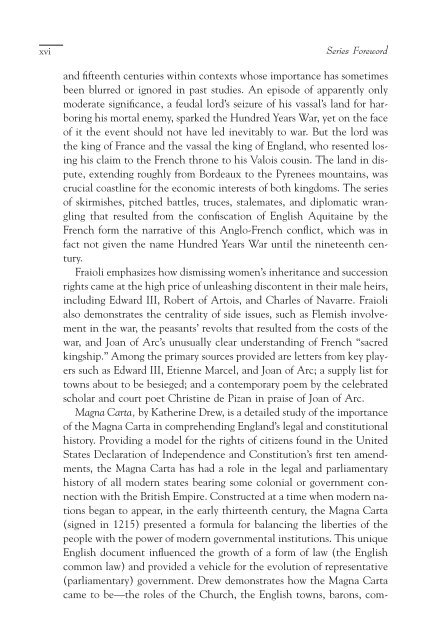CITIES AND TOWN The medieval city.pdf
CITIES AND TOWN The medieval city.pdf
CITIES AND TOWN The medieval city.pdf
You also want an ePaper? Increase the reach of your titles
YUMPU automatically turns print PDFs into web optimized ePapers that Google loves.
xvi<br />
Series Foreword<br />
and fifteenth centuries within contexts whose importance has sometimes<br />
been blurred or ignored in past studies. An episode of apparently only<br />
moderate significance, a feudal lord’s seizure of his vassal’s land for harboring<br />
his mortal enemy, sparked the Hundred Years War, yet on the face<br />
of it the event should not have led inevitably to war. But the lord was<br />
the king of France and the vassal the king of England, who resented losing<br />
his claim to the French throne to his Valois cousin. <strong>The</strong> land in dispute,<br />
extending roughly from Bordeaux to the Pyrenees mountains, was<br />
crucial coastline for the economic interests of both kingdoms. <strong>The</strong> series<br />
of skirmishes, pitched battles, truces, stalemates, and diplomatic wrangling<br />
that resulted from the confiscation of English Aquitaine by the<br />
French form the narrative of this Anglo-French conflict, which was in<br />
fact not given the name Hundred Years War until the nineteenth century.<br />
Fraioli emphasizes how dismissing women’s inheritance and succession<br />
rights came at the high price of unleashing discontent in their male heirs,<br />
including Edward III, Robert of Artois, and Charles of Navarre. Fraioli<br />
also demonstrates the centrality of side issues, such as Flemish involvement<br />
in the war, the peasants’ revolts that resulted from the costs of the<br />
war, and Joan of Arc’s unusually clear understanding of French “sacred<br />
kingship.” Among the primary sources provided are letters from key players<br />
such as Edward III, Etienne Marcel, and Joan of Arc; a supply list for<br />
towns about to be besieged; and a contemporary poem by the celebrated<br />
scholar and court poet Christine de Pizan in praise of Joan of Arc.<br />
Magna Carta, by Katherine Drew, is a detailed study of the importance<br />
of the Magna Carta in comprehending England’s legal and constitutional<br />
history. Providing a model for the rights of citizens found in the United<br />
States Declaration of Independence and Constitution’s first ten amendments,<br />
the Magna Carta has had a role in the legal and parliamentary<br />
history of all modern states bearing some colonial or government connection<br />
with the British Empire. Constructed at a time when modern nations<br />
began to appear, in the early thirteenth century, the Magna Carta<br />
(signed in 1215) presented a formula for balancing the liberties of the<br />
people with the power of modern governmental institutions. This unique<br />
English document influenced the growth of a form of law (the English<br />
common law) and provided a vehicle for the evolution of representative<br />
(parliamentary) government. Drew demonstrates how the Magna Carta<br />
came to be—the roles of the Church, the English towns, barons, com-
















